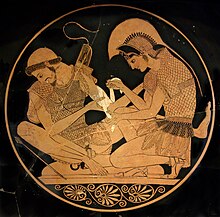
Back Leinenpanzer German Linotórax Spanish Linothorax French Linothorax ID Linothorax Italian Lininė kirasa Lithuanian Линоторакс Russian Ліноторакс Ukrainian 亞麻胸甲 Chinese

The linothorax (/ˈliːnoʊθɔːræks/, from the Ancient Greek: λινοθώραξ, Ancient Greek: [linotʰɔ̌ːraːks]) is a type of upper body armor that was used throughout the ancient Mediterranean world. The term linothorax is a modern term based on the Greek λινοθώραξ, which means "wearing a breastplate of linen";[1] A number of ancient Greek and Latin texts from the 6th century BC to the third century AD mention θώρακες λίνεοι (thorakes lineoi) (Greek) or loricae linteae (Latin) which means 'linen body armour'. These are usually equated with some of the armours showed in sculptures and paintings from Italy and Greece from 575 BC onwards. Very little is known about how ancient linen armour was made. Linen armour in other cultures was usually quilted and stuffed with loose fibre or stitched together many layers thick, but it could also have been made with a special weave called twining which creates a thick, tough fabric.[2] The theory that it was made of layers of linen glued together comes from a mistranslation of a summary of a description of medieval armour in 1869.[3]
By the late 6th century BC, many paintings and sculptures show hoplites and other warriors in the Aegean wearing the linothorax instead of a bronze cuirass. This could have been due to the lower price, lesser weight, or cooler material. Artists continue to show it in the Hellenistic period after the death of Alexander the Great. The Roman emperor Caracalla equipped a "Macedonian phalanx" with linen armour around 200 AD (Cassius Dio 78.7).
- ^ λινοθώραξ. Liddell, Henry George; Scott, Robert; A Greek–English Lexicon at the Perseus Project.
- ^ Granger-Taylor, H. (2012). "Fragments of Linen from Masada, Israel – the Remains of Pteryges? – and Related Finds in Weft-and Warp-Twining Including Several Slings". In Nosch, Marie-Louise (ed.). Wearing the Cloak: Dressing the Soldier in Roman Times. Ancient Textiles Series. Vol. 10. Oxford: Oxbow Books. pp. 56–84.
- ^ Manning, S. (2021). "The History of the Idea of Glued Linen Armour". Mouseion. 17 (3): 492–514. doi:10.3138/mous.17.3.003. S2CID 237688950.
© MMXXIII Rich X Search. We shall prevail. All rights reserved. Rich X Search